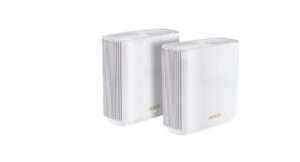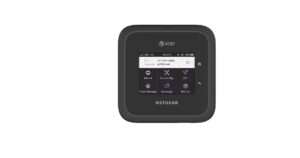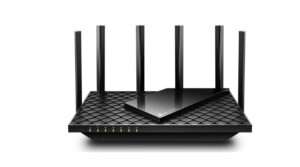With the addition of Wi-Fi 6E capability, the Eero Pro 6E delivers an improvement over the Eero 6 Plus and all previous Eero systems. The system is clocked by Eero with an AX5400 speed rating, which reaches maximum theoretical rates of 800Mbps on the 2.4GHz band and 2.3Gbps on the 5GHz and 6GHz bands.Every Eero Pro 6E router should cover approximately 2,000 square feet and be able to connect at least 100 devices. How much is Eero Pro 6E ethernet port speed extender price?
Eero Pro 6E ethernet port speed extender YouTube video review
Eero Pro 6E extender user manual setup
Pros & Cons
Pros
- 2.5Gbps WAN port with
- Integrated Thread/Matter and Zigbee support
- Simple to set up
- Adherence to Wi-Fi 6E
- Quick throughput rates
- WAN port with several gigabits
- Elegant, discrete nodes
Cons
- No USB ports
- Parental control and network security software not included
Eero Pro 6E Specs
- Wireless Specification 802.11ax
- Wi-Fi Speed (Total Rated Throughput) AXE5400
- Number of Wired LAN Ports (Excluding WAN Port) 1 on router, 2 on satellites
- Number of Bands 3
- Number of USB ports No
- Number of Antennas 7
- MU-MIMO Yes
- IPv6 Compatible Yes
- Quality of Service (QoS) No
- Security WPA2, WPA3
- Parental Controls Yes
- Anti-Malware Tools Yes
- Coverage Area for Hardware as Tested 6000 sq ft
- Number of Nodes 2
- Wired Backhaul Yes
- Separate Bands No
- DD-WRT / Tomato-Compatible No
- Size: 5.5 x 5.5 x 2.1 inches
- Estimated Annual Electricity Cost: $61.80 (includes host and two satellites)
Compare Eero Pro 6E
Eero 6 Plus
Amazon’s second swing at Wi-Fi 6
Speed rating: AX3000
Design: Dualband (2.4 and 5GHz)
Ports: Two 1Gbps Ethernet jacks, USB-C power jack
Extras: Built-in Zigbee smart home radio, Matter support via Thread
Hardware: 1GHz dual-core processor, 512MB of RAM, 4GB of Flash storage
Range: 4,500 sq. ft. (three-pack)
Individual price: $139
Three-pack price: $299
Eero Pro 6E
The first Eero system that supports Wi-Fi 6E
Speed rating: AX5400
Design: Triband (2.4, 5, and 6GHz)
Ports: Two Ethernet jacks (2.5Gbps and 1Gbps), USB-C power jack
Extras: Built-in Zigbee smart home radio, Matter support via Thread
Hardware: 1GHz dual-core processor, 1GB of RAM, 4GB of flash storage
Range: 6,000 sq. ft. (three-pack)
Individual price: $250
Three-pack price: $550
Eero Pro 6E ethernet port speed extender price
We tried the $499 Eero Pro 6E two-pack, which covers up to 4,000 square feet of living space, for this review. For $299, you may purchase a single node that covers 2,000 square feet if you don’t require that much coverage. Alternatively, the $699 three-pack covers 6,000 square feet if you need to go large.
Eero Pro 6E ethernet port speed extender setup & review
Design
The white nodes remain the same, and they have the recognizable low-profile, curved design of earlier Eero devices. However, they are slightly larger than the Eero 6 Plus nodes (2.6 by 3.9 by 3.8 inches) at 2.2 by 5.5 by 5.5 inches (HWD).
Each node has a tiny LED indicator on top that flashes blue during setup and glows solid white when everything is connected and operating as it should. When the node loses its internet connection, a red LED illuminates.
Other networking devices’ ventilation holes and slots are absent from the eero Pro 6E’s design. The devices may warm up while in use, but they won’t get hot to the touch. They were significantly colder than the Pro 6 units, peaking at 104 degrees Fahrenheit.
Ports
Two auto-sensing WAN/LAN ports—one 2.5GbE port and the other 1GbE port—and a USB-C power port are located around rear. For wired backhaul, one of the ports can be utilized. The Eero Pro 6E lacks USB connectivity for printers and other devices, similar to previous Eero systems, even though it gets power from a USB cable. The Asus ZenWiFi ET8 mesh system has this feature. How much does the Ethernet port speed extender Eero Pro 6E cost?
Coverage
We tried the Eero Pro 6E two-pack, which offers coverage for homes up to 4,000 square feet, for this review. You can purchase a single node for 2,000 square feet of coverage if you don’t require that much coverage. Alternatively, the three-pack offers 6,000 square feet if you need to go large.
WiFi Chip
A 1GHz dual-core CPU, 1GB RAM, and 4GB flash storage power the Eero Pro 6E. It has a Zigbee radio built in, so you can use it to operate thermostats, cameras, locks, and other home automation equipment. Additionally, it is compatible with the Thread networking protocol, which is intended to improve connectivity in smart homes.
Transfer speed
The maximum theoretical speeds of this AX5400 system are 800 Mbps on the 2.4GHz band, 2.3 GHz on the 5GHz band, and 2.3 GHz on the 6GHz band. Furthermore, it is a Wi-Fi 6E system, meaning that 6GHz data transfers are available in addition to 2.4GHz and 5GHz data transmissions. It is compatible with all of the most recent Wi-Fi 6 technologies, such as 160MHz channel broadcasts, WPA3 encryption, MU-MIMO simultaneous data streaming, direct-to-client signal beamforming, and orthogonal frequency-division multiple access (OFDMA) data transmissions.
Subscription
The Eero Pro 6E lacks free parental control and anti-malware software, just like previous Eero systems, but you can get both by signing up for an Eero Secure subscription. The package costs $2.99 per month or $29.99 per year and includes security checks, user profile creation, ad blocking, and parental controls (such as content filters that prevent access to adult-oriented websites).
The $9.99 monthly or $99 annual Eero Secure Plus subscription includes all of the features of the Secure plan in addition to Malwarebytes antivirus software, DDNS remote network access software, 1Password password management software, and Encrypt.me VPN software for enhanced security.
eero app
The intuitive smartphone app available for older Eero systems is also available for the Eero Pro 6E. The application launches into a Home page that displays panels for each connected node and internet connectivity. You may examine upload and download speeds and do a speed test by tapping the internet panel. To view the node’s IP address, data rate, connected clients, and mode of connection (wired or wireless), tap one of the node panels.
The buttons for Home, Activity, Discover, and Settings are located at the bottom of the screen. To view upload and download speeds, the quantity of data uploaded and downloaded, the number of security scans completed, and the number of security threats prevented, use the Home button to go back to the Home screen.
Eero Pro 6E performance review
In the 5GHz close-proximity (same room) test, the router node scored 925Mbps, which outperformed the Asus ZenWiFi ET8 (869Mbps), the Linksys Atlas Max 6E (806Mbps), and the TP-Link Deco XE75 Pro (853Mbps). Once again, the router outperformed the TP-Link XE75 Pro (322Mbps) and the Linksys Atlas Max 6E (300Mbps) at a distance of 30 feet, but not the Asus ZenWiFi ET8 (350Mbps).
The Asus ZenWiFi ET8 node scored 787Mbps, the Linksys Atlas Max 6E node scored 792Mbps, and the TP-Link DECO XE75 Pro node achieved 801Mbps in the close-proximity test, which was the top scorer. The Eero Pro 6E satellite node achieved 565Mbps on the 30-foot test, outperforming the Asus ZenWiFi ET8 node (531Mbps), the Linksys Atlas Max 6E node (515Mbps), and the TP-Link XE75 Pro node (512Mbps).
Eero Pro 6E alternative
TP-Link Deco W7200
TP-Link had a very successful year this year, and it wasn’t all due to the Archer AX21. Additionally, there is the TP-Link Deco W7200, which easily passed my speed tests and is now my choice for the best mesh router of the year. It’s an excellent choice for large homes and won’t cost you a lot of money because it uses numerous devices to function as a team of routers to distribute a faster, more dependable signal over a larger area than a single router can.
In addition to having complete support for Wi-Fi 6, the Deco W7200 is a superb tri-band model with two bands: 2.4 and 5GHz. It also has a fifth band, which is used by the system as a specialized wireless backhaul link between the main router and its satellites. The optimal mesh performance can only be accessed with that dedicated backhaul since it isolates those system transmissions apart from your normal network traffic. Such tri-band mesh routers often run you $300 or more, but the Deco W7200 costs $100 less.
As I tested the system, the performance was indeed exceptional. As a matter of fact, out of all the mesh routers I tested at home, only two had quicker download averages; the more expensive of the two, the first costs more than $200 more than the Deco W7200. Because of this, investing in the Deco W7200 is an incredible deal and a better, more apparent upgrade for the majority of homes than going with a pricy basic router.



